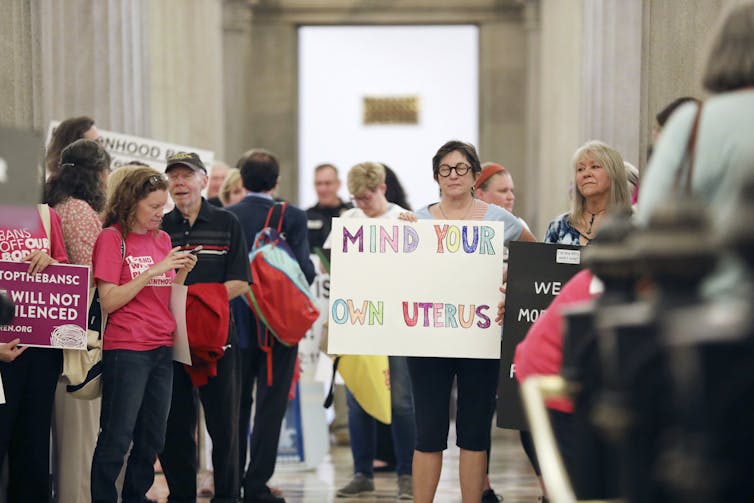Since the U.S. Supreme Court’s Dobbs v. Jackson ruling, abortion care has become a patchwork of confusing state laws that deepen existing inequalities, writes Heidi Fantasia.

The range of reproductive health care available to women depends significantly on the state they live in. (fizkes/iStock via Getty Images Plus)
By Heidi Fantasia
UMass Lowell
 In the year since the U.S. Supreme Court’s Dobbs v. Jackson ruling struck down the constitutional right to abortion, society has been seeing the results of a post-Roe world.
In the year since the U.S. Supreme Court’s Dobbs v. Jackson ruling struck down the constitutional right to abortion, society has been seeing the results of a post-Roe world.
While there is no law in the U.S. that regulates what a man can do with his body, the reproductive health of women is now more regulated than it has been in 50 years. And the scope of reproductive health care that women can receive is highly dependent on where they live.
This creates a system of inequalities and further exacerbates health disparities.
I am a nurse practitioner who studies women’s reproductive health across the lifespan. My research found that college women are concerned about pregnancy, but they lack knowledge and skills about navigating sexual consent and often participate in sexual activity without explicit consent, leaving them at risk for not using contraception and exposure to sexually transmitted infections.
These findings indicate that women are at risk of pregnancy at a historic time when women’s reproductive rights in the U.S. are restricted and not guaranteed.
Current State of Abortion in the US
The Dobbs v. Jackson ruling returned decisions regarding abortion to individual states. This has led to a patchwork of laws that span the entire range from complete bans and tight restrictions to full state protection for abortion.
In some states, such as Texas, Louisiana and Mississippi, abortion is banned beginning at six weeks gestational age, when very few women even know they are pregnant. Other states, such as Massachusetts, Vermont, New York and Oregon, have enacted state-level protections for abortion.
The patchwork of state laws also results in a great deal of confusion. In the past year, women’s rights organizations and women’s health advocates have brought numerous legal challenges to restrictive abortion laws. These cases have halted the implementation of some of the strictest abortion regulations until additional court rulings are finalized.

Protesters against a stricter abortion ban in the State House lobby on May 23 in Columbia, S.C. (AP Photo/Jeffrey Collins)
Effects on Care Providers
Abortion training is considered essential health care and a core competency for physicians in obstetrics and gynecology, or OB-GYN, residency programs. Approximately 50 percent of OB-GYN residency programs are located in states with restricted or highly restricted access to abortion. This will logically result in not only fewer health care providers being trained to perform gynecologic procedures for abortion, but also other conditions such as miscarriage, fetal death and nonviable pregnancies.
In states with changing abortion laws and legal challenges to new laws, physicians are uncertain of what procedures can be legally done. Penalties for violating abortion laws may include arrest, loss of medical license, fines and discipline by state boards of medicine.
As a result, physicians are choosing to leave states with the most restrictive abortion laws, and clinics are closing, which is contributing to the current shortage of health care providers.
Inequalities in Health Care Access
The unequal access to abortion procedures across the country is most directly affecting the poorest women in the U.S.
Currently, 12 states restrict abortion coverage by private insurance, and more than 30 states prohibit public Medicaid payment for abortion. Women who qualify for Medicaid are among the poorest in the U.S. Lack of access to abortion limits education and wage earning and contributes to poverty. States with the most restrictive abortion laws also have limited access to pregnancy care and supportive programs for pregnant and parenting women.
In addition, traveling to a different state to obtain an abortion is often not possible for poor women. Lack of transportation and limited financial resources reduce or eliminate options to obtain an abortion in a different geographic location.
What’s more, states with the most abortion restrictions have some of the worst pregnancy and maternal health outcomes for women, especially women of color. Pregnancy itself is associated with a risk of dying.
Maternal morbidity is the term used to describe short- or long-term health problems that result from pregnancy. Maternal mortality refers to the death of women during pregnancy or within the first six weeks after birth.
For example, Mississippi and Louisiana have the highest rates of maternal mortality in the U.S. and also have the most restrictive abortion laws. Black women have the highest maternal mortality of all races and ethnicities. Women in these states who are unable to terminate a pregnancy have a higher risk of dying as a result of the pregnancy than women in other states.
Additionally, research shows that a woman’s risk of dying related to pregnancy or childbirth is about 14 times higher than the risk of death from an abortion.
In addition to the increased risks of death, there are other physical and mental health implications associated with carrying an undesired pregnancy to term. Being denied access to abortion is associated with increased anxiety and fewer future plans for the next year. Research also shows that not being able to obtain an abortion makes women more likely to live below the federal poverty level and to lack partner support.
Conversely, research has shown that there are few if any significant negative mental health outcomes among women who have abortions.
Unsafe Abortions
Restricting legal abortion increases the risk that women will seek out pregnancy termination from unskilled people in unsafe settings. Or they may not seek care quickly for pregnancy complications due to fear of being accused of a crime.
In Texas, physicians are reporting an increase in sepsis, or an overwhelming response to infection, from incomplete abortions. These physicians predict that sepsis will become the leading cause of maternal death in Texas.
Prior to 1973, when Roe v. Wade established constitutional protection for abortion in the U.S., women often resorted to unsafe methods to induce abortion that resulted in a high death toll. Septic abortion wards – or designated areas of hospitals where women were treated for sepsis as a result of illegal abortions – were common. In 1965, 17% of all deaths related to pregnancy were attributed to illegal abortion.
Now that the constitutional right to abortion has been eliminated, more women will inevitably die or become seriously ill due to lack of safe access to abortion services. In states with the most restrictions on abortion, whether a woman meets the criteria for an exemption to save the life of the mother may be decided by a hospital committee. This can delay necessary care and increase the risk to the mother.
Women Affected by Violence
In the U.S., more than 25 percent of women will experience physical or sexual violence in their lifetime. Violence from an intimate partner is a leading reason for abortion. My research shows that women affected by violence have a higher risk of pregnancy and that college women are at increased risk of nonconsensual and forced sexual encounters.
Currently, there are 14 states with abortion bans that contain no exception for rape or incest or require that the sexual assault be reported to law enforcement to qualify for exception.
Research has shown that women often don’t report sexual assault due to stigma, embarrassment or fear of not being believed. Even if women qualify for an abortion as a result of sexual violence, those who have not filed a formal police report lack “proof” that their pregnancy resulted from assault.
While the changes that have occurred since the fall of Roe one year ago are already deeply concerning, the full effect of eliminating the constitutional right to an abortion won’t be known for years. And as laws are enacted and subsequently challenged, uncertainty and confusion regarding women’s reproductive health care will undoubtedly continue for years to come.![]()
Heidi Fantasia is associate professor of nursing, UMass Lowell.
This article is republished from The Conversation under a Creative Commons license. Read the original article.
The views expressed are solely those of the author and may or may not reflect those of Consortium News.
Support CN’s Spring
Fund Drive Today



This reminds me that I am not feeling at all bad about having ended a 30 year friendship in 2005 after my friend voted for George W. Bush a second time in 2004. Samuel Alito, who wrote the majority opinion for Dobbs vs. Jackson, was appointed by Bush.
My friend was a fundamentalist Christian but he did not fit the worst stereotypes of people of that persuasion. He and I met in the mid 1970’s when we were both graduate students and working at a part time job sponsored by our state university. I was a Christian at the time but not a fundamentalist Christian. He and I hit it off and became friends. My friend was accepting when I later had my reasons for being unhappy with Christianity and decided I was no longer a Christian.
I was bothered in 2000 when my friend was going to be voting for GWB. Anybody but Gore, and he was strongly against abortion. I was willing to accept it at the time. However I was especially bothered in 2004 when my friend indicated, without showing any signs of doubt or having any second thoughts, that he was going to be voting for GWB again.
My friend was never “in-your-face” about his religion or politics, and I never thought of him as being bigoted or intolerant. However I was very bothered that my friend supported the candidate who was supported by people in the Religious Right who are bigoted, intolerant, and “in-your-face”.
And my friend was very much in favor of the Iraq war.
I let my friend know that I needed to reevaluate my friendship with him. I proposed that if we got together then we could talk about old times, and about work, school, and people we both knew. However I did not want to hear my friend’s thoughts about any controversial issue, and I particularly did not want to hear about any of my friend’s or his family’s church or Christian activities. I said that to my friend knowing that church and Christian activities were very important to my friend and his family. His wife was a music teacher at a Christian elementary school, and had a singing ministry, and his two daughters went to a private Christian college.
Agreeing to not talk about certain topics often works in families; however my friend preferred to end our friendship if he felt that our friendship was subject to reevaluation based on religious or political differences, or if we couldn’t talk about certain things. We ended our friendship on amicable terms, and agreed we could have fond memories of our past relationship and exchanged best wished for each other’s futures. We had been good friends but after his voting for GWB a second time, and being in favor of the Iraq War, I could no longer respect my friend’s politics or especially his religious faith. And recent Supreme Court decisions, Dobbs vs. Jackson and several others, by “justices”, including a couple appointed by GWB, have confirmed for me that it was the right thing for us to end our friendship, and I am happy about our having done so.
Every human being on the planet has a right to personal autonomy, period. Certainly, a woman’s decision to abort or carry a fetus to term falls well inside her right to personal autonomy. There is no need for Roe vs Wade, never has been.
As noted with reserved asperity in the Court’s majority decision in Dobbs vs Jackson, Roe vs Wade was a fiat judicial end run on the legislature, and absolute crap for reasoning besides. It has deserved its dustbin for all these years.
Rights are not obtained by laws or judicial decision. Rights are inherent in the individual, and can neither be granted or rescinded by any means whatsoever.
If abortion advocates had bothered understanding this, there might have been a solid constitutional law delineating and guaranteeing personal autonomy and explicitly acknowledging a woman’s right to choose well before Roe v Wade muddied the constitutional issues with an execrable decision that was not going to stand its first real test for the very good reason that it sucked.
Democrats have never been in favor of such a clear and final statement of personal autonomy by human right; Democrats prefer having the issue to agonize and incite the base they despise.
“Every human being on the planet has a right to personal autonomy, period.”
Yes … so, at what point does the child’s right to personal autonomy and indeed life begin, in your view? In other words, at what point do we have not just one human being, but two, whose inalienable rights need to be protected? Isn’t this indeed the heart of this issue, which abortion supporters seem to have trouble reckoning with?
This is so depressing. 2023 in the USA (‘the land of the free’). You are so right about there being no laws about what men can do with their bodies. They are too busy telling the women what to do with theirs. A man who does not want a child with his partner can – and often does – just walk away. No hassle. No maintenance to pay. No problem.
“The powers not delegated to the United States by the Constitution, nor prohibited by it to the States, are reserved to the States respectively, or to the people.”
All the SC did last year was note that, as there’s no explicit constitutional abortion authority, the federal govt has no business regulating it and the individual states can choose their own path. I’m happy to live in a state (CA) that takes a very liberal view of abortion rights and over time, I think most states are going to arrive at some reasonable rights laws … it’s simply supported by far too many people, now that it’s out of the S court’s hands.
“While there is no law in the U.S. that regulates what a man can do with his body…”
I find rhetoric like this is unhelpful towards building a constructive coalition. There are certainly examples of violation of male bodily autonomy if one thinks for a bit. Every day parents and physicians in the US are allowed to mutilate the genitals of male infants without any form of consent from the individual. And men and women both have been coerced into taking experimental treatments during the COVID-19 pandemic in order to keep their jobs. If you want to an unstoppable coalition for bodily autonomy, let’s recognize all forms of its violations.